#branchiopods
Photo
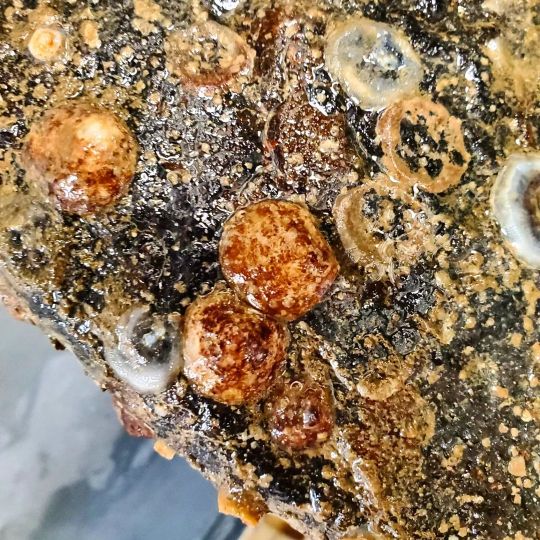
Taken the same day as the previous post, these are 'Novocrania anomala'. On the surface, they may look like limpets, but when pried off the rock, it's obvious this is a very different creature all together. It's a species of the little known phylum known as brachiopods, an ancient phylum whose lineage goes back to the Cambrian, though the order this one belongs to goes back to the Ordovician. In Sweden, this species occurs on the west coast at 1500m depths latching to bedrock and boulders wherever there's low water movement. The first thing to be noticed when seeing the body beneath the valve is its lophophore, which includes the brachial arms above that contain tentacles used for filter-feeding and the subenteric ganglion seen within the coils, the esophagus in the middle, and the posterior adductors at the bottom that it uses to remain stationary. Thank you Professor Mikael Thollesson for showing me this. #animal #animals #djur #wildlife #natur #naturliv #nature #invertebrate #invertebrates #fauna #branchiopods #brachiopods #lophotrochozoan #armfotingar #livingfossil #livingfossils #marinelife #havsliv #levandefossil #levandefossiler #animalia #lophotrochozoa #brachiopoda #craniata #craniida #craniidae #novocrania #novocraniaanomala (at Klubbans biologiska station) https://www.instagram.com/p/CeW05CiqZYA/?igshid=NGJjMDIxMWI=
#animal#animals#djur#wildlife#natur#naturliv#nature#invertebrate#invertebrates#fauna#branchiopods#brachiopods#lophotrochozoan#armfotingar#livingfossil#livingfossils#marinelife#havsliv#levandefossil#levandefossiler#animalia#lophotrochozoa#brachiopoda#craniata#craniida#craniidae#novocrania#novocraniaanomala
0 notes
Text

Panacanthocaris ketmenica* here was a member of an extinct group of crustaceans known as kazacharthrans – close relatives of modern tadpole shrimp known mainly from Central Asia during the mid-to-late Triassic (but with possible German relatives from both the late Triassic and further back in the late Paleozoic).
Fossils of Panacanthocaris have been found in Kazakhstan and northwest China, dating to about 235-221 million years ago. It was fairly big compared to most of its modern cousins, reaching at least 10cm in length (~4"), and had distinctive spines around the edges of its carapace and its telson.
It's not clear if it had eyes – there's a single opening near the front of its carapace that may have housed some, and so I've depicted it here with just one naupliar eye similar to the "third eye" of tadpole shrimp.
It probably had a fairly similar lifestyle to its modern relatives, living in shallow freshwater and temporary pools and opportunistically feeding on everything from algae to smaller aquatic animals.
(* Sometimes also called P. ketmenia. May also be the same thing as Iliella spinosa, but until that paper is officially published the current name still stands.)
———
NixIllustration.com | Tumblr | Patreon
#science illustration#paleontology#paleoart#palaeoblr#panacanthocaris#ilellia#ketmeniidae#kazacharthra#branchiopod#crustacean#arthropod#invertebrate#art#triassic weirdos
248 notes
·
View notes
Text
My teen foreskin dick pissing around a house
Tattooed yard worker fucks boss in bondage
Esposa mexicana amateur cogiendo anal
Blonde angel dildoing her pussy
namorada puta dando de quatro no motel quase chora na pica
Loads of cum all over future secretary Lexi Dona after Hardcore office fuck
sexy co worker affair rio
Fucking Stripper after party
Real Teen Backpage Spinner
Slut with big natural boobs Skylar Snow ass fucked by hard cock
#emmew#magneta#owercome#borofluoric#good-naturedly#UCAR#areche#Diatomeae#Kwasi#dishevelling#ROUS#Evelina#santims#chatterers#floorers#branchiopod#subfreshman#Platinite#outplodded#prereform
0 notes
Note
music asks 1 and 28 :) 🎧
1: a song you like with a colour in the title
pink light by muna vs pink in the night by mitski FIGHT
28: a song from an artist with a voice that you love
shrike by hozier!!
0 notes
Text
Transcript:
Why don't we spice this match up with a fact about shrimp:
Do you know the female shrimp can lay up to a hundred million eggs at once? Wow, that's…. that number seems a bit high, actually.
Did you know that average shrimp lifespan is between 12 and 16 minutes? Wow, I sure know a lot more about shrimp than I did before this match!
Did you know that shrimp subclass Branchiopoda, order Anostraca are on average 3 inches smaller than the more common branchiopods Notostraca, Diplostraca and Mysidacea? …..okay!
Did you know that the first shrimp was discovered in 1967 by a group of Finnish sailors? I didn't either, facts can really be surprising!
Did you know that shrimp are healthy source of protein and selenium? I did, and I use this information on a regular basis!
#posting shrimp facts for my birthday yayayayay#request audio#voice#the stanley parable#dota 2 announcer pack
260 notes
·
View notes
Note
hey did you know that a recent-ish study found that the clade Hexapoda are closer to half of Crustacea than that half is to the other half? Placing Hexapods, including all insects within Crustaceans, with their closest relatives being Branchiopods like Triops? <|:3
WOAH. im gonna have to google half these terms when i have time
12 notes
·
View notes
Text
cannot believe i’m gonna be doing a branchiopod study. the position i got hired onto is ab Bythotrephes longimanus

2 notes
·
View notes
Text
Today I researched the animals that made the fossils in Limerick’s limestone. With a quick search, I found a fossil trail for tourists on the UCC website. I’ve attached the site below.

From there, I researched the original animals in the fossils. The two most common animals were Branchiopods and Gastropods, so I focused on drawing variations of the two.
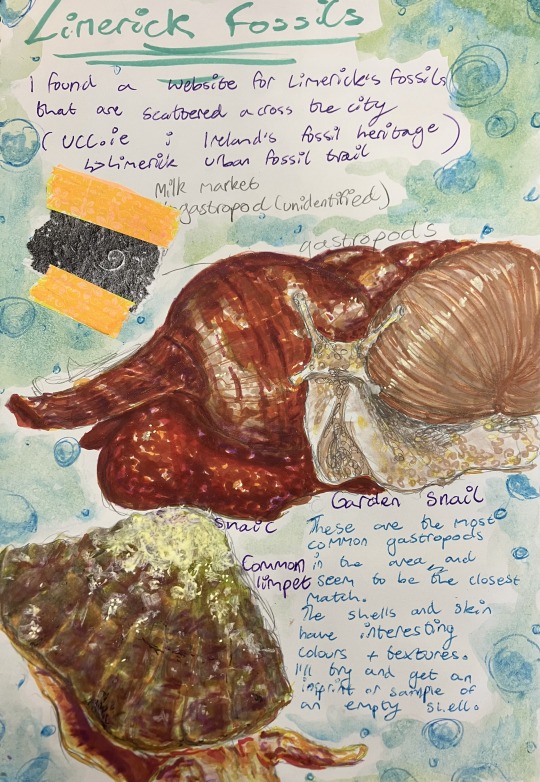
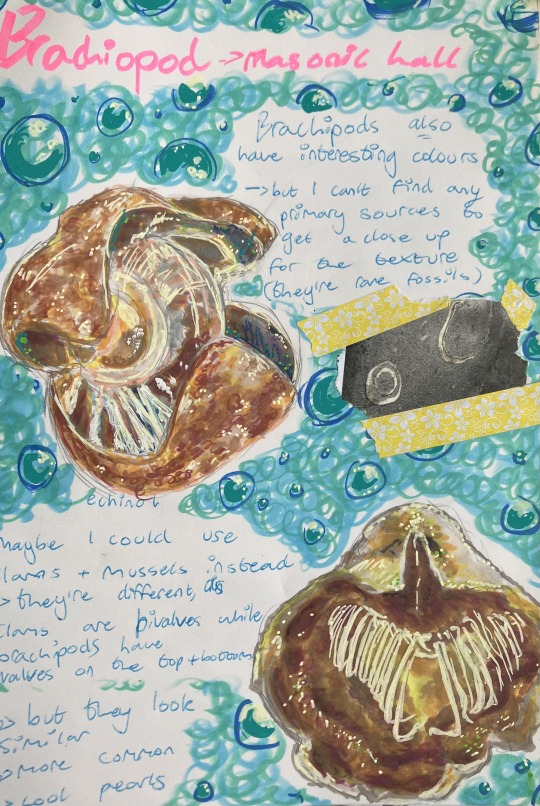
While gastropods were easy enough to find in Limerick (a rainy day made all the snails come out), Brachiopods proved much more difficult to find. This makes sense - most of them are extinct - but it meant that I had to rely on secondary sources to draw them. I almost used clams and oysters as a primary source, but realised that they differed to greatly from the originators.
0 notes
Photo


made a Triops earring today!!
#triops#polymer clay#shrimp#where are my branchiopod fans at?#I'm raising triops at the moment and they're so sweet and wiggly#just can't stop thinking about them
13 notes
·
View notes
Text
arcticarthropod replied to your photo: it’s time to think about flies. it’s time to think...
I would like to nominate you to be the person who decides what we should think about at any given time.
that’s perfect because now it’s time to think about this clam shrimp i found
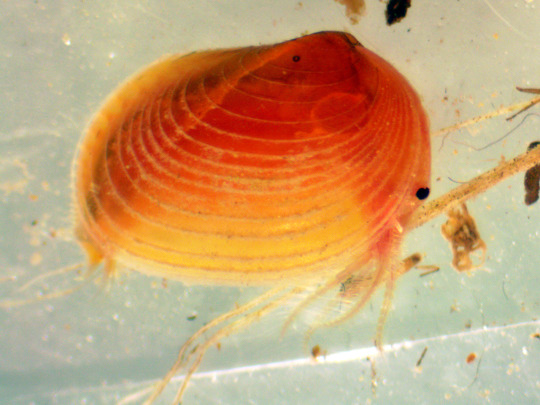

#arcticarthropod#clam shrimp#bflyphotos#branchiopod#hey this xkit reply thing is handy#wish i bothered to install it like 3 years ago
1K notes
·
View notes
Text
ɴᴏᴡ ᴘʟᴀʏɪɴɢ: Fireflies by Owl City
───────────────⚪───────────────────
◄◄⠀▐▐ ⠀►►⠀⠀ ⠀ 1:17 / 3:48 ⠀ ───○ 🔊⠀ ᴴᴰ ⚙ ❐ ⊏⊐


Can you believe that these glowing light in the waters are sea fireflies? Everything is indeed never as it seems.
I bet you were awestruck[cod]!
Now, these millions of sea fireflies would like to wave “Hi!” as you go through the blog and get to know the bioluminescent ostracods under genus Vargula.
CLASSIFICATION
Kingdom: Animalia
Subkingdom: Bilateria
Infrakingdom: Protostomia
Superphylum: Ecdysozoa
Phylum: Arthropoda
Subphylum: Crustacea
Class: Ostracoda
Subclass: Myodocopa
Order: Myodocopida
Suborder: Myodocopina
Superfamily: Cypridinoidea
Family: Cypridinidae
Genus: Vargula
Species Name: Vargula annecohenae
(ITIS nd ; Cohen and Morin, 2010)
BIOLOGY
Cod you see me?

Ostracods can be found in basically every aquatic environment ranging from marine, freshwater, and estuarine habitats. These organisms are either swimming in the surface waters or crawling on the sea bed and moist land. Their distribution depends on their adaptations to environmental parameters, mainly salinity and water temperature. Vargula species inhabit the Pacific Ocean and Caribbean Sea coastal landmasses (Wilkinson, 1996; Ogoh & Ohmiya, 2005).
Although they are everywhere, ostracods rarely grow to a few millimeters long; small but (Pechenik, 2015). A single organism can’t be easily seen unless we look closely. Still, they’re small but widespread.
What do you mistake me as?
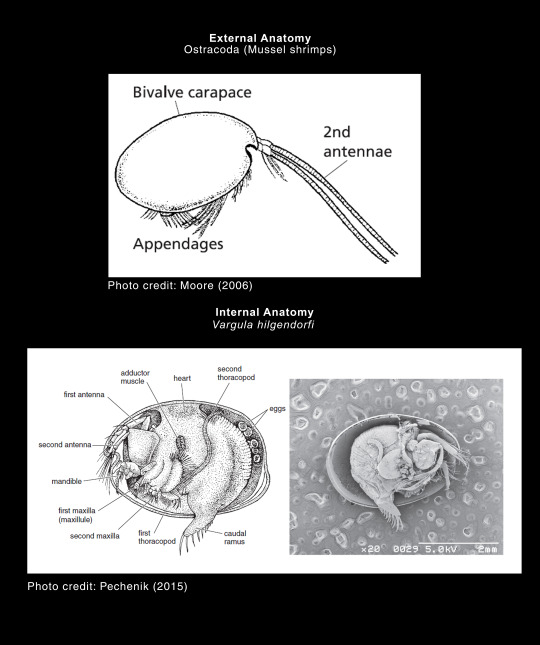
Ostracoda is an ancient group of crustaceans. Surprised?
The unsegmented external feature separates them from other crustaceans (Pechenik, 2015). Besides this, they resemble bivalves by having their entire body laterally enclosed inside a pair of partially calcified carapace or shells held by adductor muscles, even during early development; hence, the common name — mussel shrimp (Moore, 2006).

They are also similar to branchiopods Conchostraca (clam shrimps) such as water fleas, but the appendages, lack of growth rings, and smooth swimming of mussel shrimps gave it away. Another feature that differentiates both is the carapace formation. Clam shrimps add material to their carapace as they grow, while mussel shrimps shed their carapace with each molt (UC Museum of Paleontology, 1995).

Mussel shrimps are mostly head which means that the other body parts are greatly reduced. Their trunk is merged to the head. Usually, they have seven pairs of appendages adapted for locomotion, grasping, feeding, cleaning the carapace, or as sense organs. Vargula uses two pairs of antennae for swimming, some species only utilize one pair or the other. Notably, they have setae or tiny hairs protruding through the carapace pores that function for sensory mechanisms (Wilkinson, 1996; Pechenik, 2015).
youtube
A light show to remember
Bioluminescence is often used, but only by males of the species V. annecohenae, for mating displays. Males of each species, like fireflies on land, use distinct patterns of light flashes (seen as a series of dots) that only attract females of the same species. By performing brief dances in which they release short bursts of light as they pass towards the surface of the water, males show off just how sparkling they can be. They start their "dance," which lasts 45 minutes on average, with a stationary period in which brief (second-long or shorter) flashes of bright blue light are produced, attracting the interest of possible female mates. Then in the next process, males spiral up the water column vertically, producing quicker light bursts that are less bright (Gonzales, 2017).

(Courtesy of Gretchen Gerrish)
We compete to procreate
The male grabs onto his newfound partner with his antennae if a male is successful and an interested female arrives, and the pair will mate. Competition is intense, sometimes a woman's attention is won by the brightest male, but males can also impress by synchronizing their lighting display with other males or creeping up and taking a mate from another male (Gonzales,2017).
Life cycle
V. annecohenae has a long life cycle of up to about 1 year. It typically develops slowly for 3 months before adulthood. It has several broods of a few offspring numbering between 10-15, and has no free-living larval stage (Gerrish and Morin, 2008).
Five juvenile instars constitute the life cycle of Photeros annecohenae The life cycle of an ostracod in the genus Vargula (now Photeros) are divided by molts (that occur by the ecdysis) as well as an adult instar that is followed by a final molt (Gerrish and Morin, 2008).

The total growth period of ostracod eggs and embryos in females was 26 days, with an average of 7.84 days for the interval between mating and brood deposition, and an average of 18.4 days for the eventual release from the brood chamber. Eggs initially become evident within the female's body during development. While inside the mother's body, eggs increase in size but exhibit no other noticeable morphological changes. Females discharge fertilized embryos as translucent, spheroidal, or ovoidal masses into the marsupium or brood chamber (Gerrish and Morin, 2008).

(a) One egg of this female has been released into the marsupium and the four remaining eggs are visible in the female ovary. (b) The eggs are extruded into a marsupial brood pouch after 7-8 days. Each egg consists of a large yolk mass at this stage, and the cells inside are barely visible. C) Cell division has created a defined, cloudy cellular mass that fills the egg by day nine in the brood pouch. D) The first apparent structures include the naupliar eye, a red speck, and the intestine as the embryo develops its organs. E) The embryos appear as A-V instars with a large brown eye spot and a fully developed and functioning light organ just before release (Gerrish and Morin, 2008).
I have a sperm bank?
Female V. annecohenae can produce several broods without male re-exposure. suggesting that sperm is stored between broods (Gerrish and Morin, 2008).

I’m a natural
15-17 days after a previous cohort was released new broods can be formed (Gerrish and Morin, 2008).
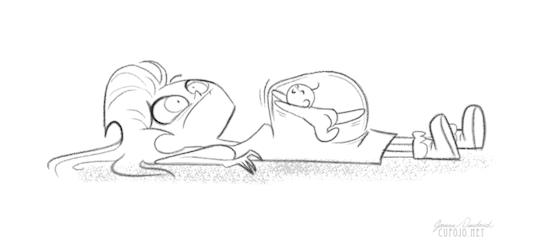
ECOLOGY
youtube
Ostracods are considered to be useful paleoenvironmental indicators because their ecology is often reflected in the shape and structure of their carapaces and also considering their wide distribution in aquatic environments. They can range from warm waters of the tropics to very cold environments such as polar seas and are found from intertidal zones to many thousands of meters depth in the deep sea. They can also thrive in freshwater niches such as rivers, lakes, and even temporary ponds (Brandão & Karanovic, 2020). Generally, ostracods are characterized as omnivorous scavengers because they mainly feed on tiny organisms like algae, diatoms, bacteria, molds, and pieces of organic detritus that are present in the water or on vegetation. Some ostracods are also predatory. Being relatively smaller, they attack their prey in groups so that they can eat organisms larger than them. However, ostracods are also often preyed by small fishes (MESA, 2020).
youtube
Freshwater ostracods usually have smooth, thin, weakly calcified simple bean-shaped carapaces and feed on diatoms, bacteria, and detritus. On the other hand, pelagic ostracods may also have thin, smooth shells but they have long powerful swimming appendages or antennules. The formation of rostral incisures at the anterior of the carapace of pelagic ostracods allowed freer movement of these appendages. Furthermore, benthic ostracods are commonly detritivores or filter feeders. Their carapace is usually smooth, small, robust, and sometimes elongated because they tend to burrow into the substrate. Epifaunal ostracods have flattened ventral surfaces sometimes with projecting alar wings, frills, keels, or lateral spines while those found on coarser substrates in higher energy environments tend to have more robust heavily ribbed or reticulated carapaces (Olney, 2002).
RELATIONSHIP TO HUMANS
Generally, ostracods are useful for scientific purposes. According to Boomer et al. (2013), ostracods are being used in studies of earth science and related disciplines such as archaeology, ecology, and genetics. This is because ostracods are widely distributed and are easily preservable. Their assemblage and morphology are some of the important ecological proxies. For instance, in recent research conducted by McCormack et al. (2018) wherein ostracods are being used as a bioindicator. Their research has shown the sensitivity of ostracods’ faunal assemblage (Candona sp.) to changes in water salinity and alkalinity in Lake Van.
Next, valves of ostracods are also being used in paleoenvironmental studies. Valves of ostracods are said to absorb trace elements from host waters (Palacios-Fest et al., 1994). This characteristic makes these microcrustaceans ideal models for reconstructing and analyzing past environments that could range from deep-seas to small lakes. Aside from this, the diversity and variety of reproductive modes of ostracods are also one of the main reasons why they are being used as model organisms for laboratory and research studies (Martens & Hornes, 2009).

Moreover, laboratories have started culturing bioluminescent ostracods. The culture of these organisms is done to determine the biosynthetic pathways of bioluminescent substrates that could lead to the discovery of new tools for biotechnology and biomedicine. For instance, in the study conducted by Goodheart et al. (2019) wherein they cultured California Sea Firefly (V. tsuji) for studies regarding the biosynthetic pathway of cypridinid luciferin and genomic manipulation of an autogenic bioluminescent system.
youtube
Serve the Teaaaaa!
The T in Osctracod means Teaaaaa! 5 amazing facts you need to know about ostracods.
1. OLD BUT GOLD

Colymbosathon ecplecticos, a species of ostracod, holds the record of oldest known fossil penis. The historical penis was discovered from a 425 million-year-old rock in England. It was said that a wide variety of animals living in the sea 425 million years ago were killed by an ash fall from a volcanic eruption. However, the ash preserved the animals, including their soft parts. Through technology, the painstaking 3-D reconstructions of a preserved male ostracod revealed amazing details such as the hairs on limbs, gills, and a penis.
2. LIGHT IT UP LIKE A DYNAMITE
youtube
Some species of Myodocopida ostracods produce a bright blue light. These are known in Japan as Umi-Hotaru or sea-fireflies. The light is produced by mixing two chemicals together in the presence of oxygen and is for mating displays. Each species flash at different rates to stop any confusion in the dark. Japanese army collected Umi-Hotaru in baited traps during the Second World War. They dry them out and ground them down to a powder. Adding a small amount of water to the powder produces a low-intensity light used by soldiers to read orders or maps without giving their position away to the enemy during battles.
3. ULTIMATE SURVIVOR

Ostracods can survive being eaten by fish. Experiments with the ostracod Cypridopsis vidua showed that 26% of specimens eaten by small bluegill sunfish came out the other end alive and unharmed. This is possible because ostracods can close their shells very tightly inside their carapace to survive passage through the gut of the fish eventually to be excreted out by the fish.
4. OSTRACODS ARE OMNIPRESENT

Ostracods are found in almost every aquatic habitat, even in some very small and isolated places. They are found deep in the sea, on the shore, on wet leaf litters, springs, groundwaters, puddles, small pools, rice fields, ponds, lakes, and rivers. Some species have a global distribution and are found from the subarctic to the tropics. Their dispersal abilities caused this massive distribution of ostracods. For example, the eggs and adults can hitch a lift on the feet of birds and are displaced because of migration.
5. WE DON’T DIE, JUST DRY

The ostracod eggs can be viable many years after being dried. This is the reason why many freshwater ostracods can be found in temporary water bodies, such as puddles and rice fields. These eggs start to develop and hatch when water is already available in their environment
References
Boomer, I., et al. (2003). The Use of Ostracods in Palaeoenvironmental Studies, or What can you do with an Ostracod Shell? The Paleontological Society Papers. https://doi.org/10.1017/S1089332600002199
Brandão, S.N.; Karanovic, I. (2020). World Ostracoda Database. Accessed at http://www.marinespecies.org/ostracoda on 2020-11-15. doi:10.14284/364
Cohen, A. C.; Morin, J. G. (2010). Two New Bioluminescent Ostracode Genera, Enewton And Photeros (Myodocopida: Cypridinidae), with Three New Species from Jamaica. Journal of Crustacean Biology. 30(1): 1-55., https://doi.org/10.1651/08-3075.1
Gonzales, M.R. (2017). You Light Up My World! Smithsonian. https://ocean.si.edu/ocean-life/invertebrates/you-light-my-world
Goodheart, J., et al. (2019). Laboratory culture of the California Sea Firefly Vargula tsujii (Ostracoda: Cypridinidae): Developing a model system for the evolution of marine bioluminescence. Research Gate. https://www.researchgate.net/publication/334600678_Laboratory_culture_of_the_California_Sea_Firefly_Vargula_tsujii_Ostracoda_Cypridinidae_Developing_a_model_system_for_the_evolution_of_marine_bioluminescence
Gretchen A. Gerrish, James G. Morin, Life Cycle of a Bioluminescent Marine Ostracode, Vargula Annecohenae (Myodocopida: Cypridinidae), Journal of Crustacean Biology, Volume 28, Issue 4, 1 October 2008, Pages 669–674, https://doi.org/10.1651/07-2934.1
Horne, D. J. & Smith, R. J. (2004). First British record of Potamocypris humilis (Sars, 1924), a freshwater ostracod with a disjunct distribution in northern Europe and southern Africa. Bollettino della Societe Paleontologica Italiana, 43 (1-2), 297-306.
Laessle, A. M. 1961. A micro-limnological study of Jamaican Bromeliads. Ecology, 42, 499-517.
Martens, K., and Horne, D.J. (2009). Ostracoda. https://doi.org/10.1016/B978-012370626-3.00184-8
McCormack, J., et al. 2019. Ostracods as ecological and isotopic indicators of lake water salinity changes: the Lake Van example. Biogeosciences, 16, 2095–2114, 2019 https://doi.org/10.5194/bg-16-2095-2019
MESA. 2020. Ostracods. Marine Education Society of Australia. http://www.mesa.edu.au/crustaceans/crustaceans03.asp
Moore, J. (2006). An Introduction to the Invertebrates (2nd ed.). Cambridge University Press.
Morin, J. G. and Cohen, A. C. 1991. Bioluminescent displays, courtship, and reproduction in ostracodes. In R. Bauer and Martin, J. (Eds.), Crustacean Sexual Biology:1 16. New York:Columbia University Press.
Ogoh, K. Ohmiya, Y. (2005). Biogeography of Luminous Marine Ostracod Driven Irreversibly by the Japan Current. Molecular Biology Evolution, 22(7):1543-1545. https://doi.org/10.1093/molbev/msi155]
Olney, M. (2002). Ostracods. Microfossil image recovery and circulation for learning and education. https://www.ucl.ac.uk/GeolSci/micropal/ostracod.html
Palacios-Fest, M.R., et al. (1994). Use of ostracodes as paleoenvironmental tools in the interpretation of ancient lacustrine records. Revista Espanola de Paleontologia 9(2):145-164. https://www.researchgate.net/publication/291990499_Use_of_ostracodes_as_paleoenvironmental_tools_in_the_interpretation_of_ancient_lacustrine_records
Pechenik, J. A. (2015). Biology of Invertebrates (7th ed.). McGraw-Hill Education.
Sars, G. O. 1895. On some South-African Entomostraca raised from dried mud. Skrifter i Videnskabs-selskabet. I. Mathematisk-Naturvidenskabs Klasse 1895 (8): 1-56.
Sars, G. O. 1896. On some west Australian Entomostraca raised from dried sand. Arch. Math. Naturv. 18, 1-35.
Seidel, B. 1989. Phoresis of Cyclocypris ovum (Jurine) (Ostracoda, Podocopida, Cyprididae) on Bombina variegata (L.) (Anura, Amphibia) and Triruris vulgaris (L.) (Urodela, Amphibia). Crustaceana 57, 171-176.
Siveter, D. J., Sutton, M. D., Briggs, D. E. G. & Siveter, D. J. 2003. An ostracod crustacean with soft parts from the Lower Silurian. Science, 302, 1749 - 1751.
UC Museum of Paleontology. (1995). Introduction to the Ostracoda. https://ucmp.berkeley.edu/arthropoda/crustacea/maxillopoda/ostracoda.html
13 notes
·
View notes
Text
Effigia okeeffeae

By Stolpergeist
Etymology: Ghost
First Described By: Nesbitt and Norell, 2006
Classification: Biota, Archaea, Proteoarchaeota, Asgardarchaeota, Eukaryota, Neokaryota, Scotokaryota Opimoda, Podiata, Amorphea, Obazoa, Opisthokonta, Holozoa, Filozoa, Choanozoa, Animalia, Eumetazoa, Parahoxozoa, Bilateria, Nephrozoa, Deuterostomia, Chordata, Olfactores, Vertebrata, Craniata, Gnathostomata, Eugnathostomata, Osteichthyes, Sarcopterygii, Rhipidistia, Tetrapodomorpha, Eotetrapodiformes, Elpistostegalia, Stegocephalia, Tetrapoda, Reptiliomorpha, Amniota, Sauropsida, Eureptilia, Romeriida, Disapsida, Neodiapsida, Sauria, Archosauromorpha, Crocopoda, Archosauriformes, Eucrocopoda, Archosauria, Pseudosuchia, Suchia, Paracrocodylomorpha, Poposauroidea, Shuvosauridae
Referred Species: E. okeeffeae
Status: Extinct
Time and Place: Around 205 million years ago, in the Rhaetian of the Late Triassic

Effigia was found at Ghost Ranch in the Chinle Formation in New Mexico
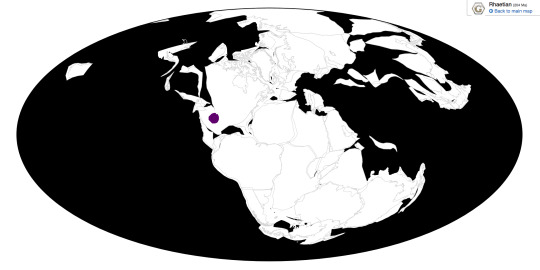
Physical Description: Effigia was a small, bipedal animal that remarkably resembled dinosaurs it lived with at the time. In total, from head to tail, it would have been about two meters long. It walked on two legs that were held directly underneath the body, and it had small arms that weren’t used in supporting its weight. It had a long body, with a decently sized tail and long neck. The head of Effigia was small and narrow, ending in a beak and having no teeth whatsoever. So, in short, it looked like the later Limusaurus, except it wasn’t feathered - and it wasn’t a dinosaur! This is the first known example of the lightly-built bipedal animal with a beak body plan, aka, the “ostrich” body plan, even though this iteration - the first iteration - had nothing resembling feathers or efficient breathing or hollow bones. In fact, it probably would have breathed primarily based on abdominal muscles, based on its close relatives. And it did have hollow bone walls, much like dinosaurs. Effigia also had a somewhat endothermic body temp - ie, it was closer to warm-bloodedness than modern crocodilians, and may have even been warm-blooded outright. It had five fingers on each hand, though only three of each would have claws; it had four main toes on each foot, unlike the three in theropods, and a little toe raised up (kind of like the fourth toe in theropods). It was rather front heavy, unlike theropods that lean more towards the hip, giving it a forward-leaning appearance.
Diet: Probably herbivorous. While the exact diet of Effigia is murky, the beak of this species indicates it probably would have fed on a variety of plant material, like the later mimics such as Limusaurus and Ornithomimus. However, omnivory was certainly not out of the question.
Behavior: Because Effigia was front-titled, it’s actually not clear whether or not it would have behaved similarly to the animals it resembles. In fact, it doesn’t seem very well adapted for fast movement at all - it looks exactly like the sort of creature that may have tripped over itself on a regular basis. That said, it is entirely possible that it would have balanced itself differently, or adjusted its position in such a way to make up for this oddity in posture. That said, it also had fairly short legs compared to its overall body length, so it’s doubtful that it would have been a fast mover in any position. As such, it probably would have moved slowly throughout its ecosystem, grazing on plants and following fresh vegetation where it came up and utilizing its long neck to reach into areas where food was less accessible, and grabbing on to it for feeding. It may not have been a particularly social animal though, like living archosaurs, it probably would have taken care of its young in some fashion.
Ecosystem: Ghost Ranch was a large floodplain, not quite as forested as the environment had been in earlier times (when they were literally called the “petrified forest”), however, there were still extensive dry forests that experienced dramatic dry and wet seasons each year. These seasons were interspersed with regular flooding, which lead to rapid preservation of a very diverse Late Triassic ecosystem. This was an extremely diverse habitat, with a variety of other reptiles that lived alongside Effigia. There was the slender dinosaur Coelophysis, the weirdly-toothed dinosaur Daemonosaurus, the Silesaurids Kawanasaurus and Eucoelophysis, the Lagerpetid Dromomeron, the early Crocodylomorph Hesperosuchus, the Aetosaur Stenomyti, the phytosaur Redondasaurus, the Drepanosaurs Avicranium and Drepanosaurus, the aquatic archosauriform Vancleavea, the sphenodont Whitakersaurus; coelocanths, ray-finned fish, mystery fish, and even invertebrates such as branchiopods and ostracods. It’s possible that Effigia lived alongside other animals as well, but more research is needed into the exact environment of the Chinle Formation where Effigia was found before that can be confirmed. It is entirely possible that Effigia would have been preyed upon by Coelophysis.
Other: Effigia is so freaking weird, you guys. Like, the Triassic may as well be called the Period in Which Reptiles Tried Out All The Things Dinosaurs Would Later Do (But Only Dinosaurs Would Get Paid For It). It is so similar to later Ornithomimosaurs that at least a few paleontologists used to think that the remains later called Effigia were actually dinosaurs, before their proper reassignment into the Pseudosuchians. This just emphasizes how much different reptiles were trying out new designs and new ideas in the Triassic Period, some of which superficially resembled later dinosaurs - but with surprise twists. It also demonstrates exactly how much crocodile-relatives were diversifying extensively in the Triassic, and how hard they would be hit by the end-Triassic extinction.
~ By Meig Dickson
Sources Under the Cut
Colbert, E. H.. 1947. The little dinosaurs of Ghost Ranch. Natural History 59(9):392-399-427-428.
Heckert, A. B., S. G. Lucas, L. F. Rinehart and A. P. Hunt. 2008. A new genus and species of sphenodontian from the Ghost Ranch Coelophysis Quarry (Upper Triassic: Apachean), Rock Point Formation, New Mexico, USA. Palaeontology 51(4):827-845.
Hunt, A. P., and A. G. Lucas. 1989. Late Triassic vertebrate localities in New Mexico. In S. G. Lucas and A. P. Hunt (eds.), Dawn of the Age of Dinosaurs in the American Southwest, New Mexico Museum of Natural History, Albuquerque 72-101.
Hunt, A. P., and S. G. Lucas. 1993. A new phytosaur (Reptilia: Archosauria) genus from the uppermost Triassic of the western United States and its biochonological significance. In S. G. Lucas and M. Morales (eds.), The Nonmarine Triassic. New Mexico Museum of Natural History and Science Bulletin 3:193-196.
Lucas, S. G., J. A. Spielmann, A. P. Hunt. 2007. Taxonomy of Shuvosaurus, a Late Triassic archosaur from the Chinle Group, American Southwest. New Mexico Museum of Natural History and Science Bulletin 41: 259 - 261.
Lucas, S. G., J. A. Spielmann, and L. F. Rinehart. 2013. Juvenile skull of the phytosaur Redondasaurus from the Upper Triassic of New Mexico, and phytosaur ontogeny. New Mexico Museum of Natural History and Science Bulletin 61:389-400.
Martz, J. W., B. J. Small. 2019. Non-dinosaurian dinosauromorphs from the Chinle Formation (Upper Triassic) of the Eagle Basin, northern Colorado: Dromomeron romeri (Lagerpetidae) and a new taxon, Kwanasaurus williamparkeri (Silesauridae). PeerJ 7: e7551.
Nesbitt, S., M. A. Norell. 2006. Extreme convergence in the body plans of an early suchian (Archosauria) and ornithomimid dinosaurs (Theropoda). Proceedings of the Royal Society B: Biological Sciences 273 (1590): 1045-1048.
Nesbitt, S. 2007. The anatomy of Effigia okeeffeae (Archosauria, Suchia), theropod-like convergence, and the distribution of related taxa. Bulletin of the American Museum of Natural History 302: 84.
Nesbitt, S. J., M. R. Stocker, B. J. Small and A. Downs. 2009. The osteology and relationships of Vancleavea campi (Reptilia: Archosauriformes). Zoological Journal of the Linnean Society 157:814-864.
Nesbitt, S. 2011. The Early Evolution of Archosaurs: Relationships and the Origin of Major Clades. Bulletin of the American Museum of Natural History 352: 1 - 292.
Pritchard, A. C., and S. J. Nesbitt. 2017. A bird-like skull in a Triassic diapsid reptile increases heterogeneity of the morphological and phylogenetic radiation of Diapsida. Royal Society Open Science 4:170499.
Renesto, S., J. A. Spielmann, S. G. Lucas and G. T. Spagnoli. 2010. The taxonomy and paleobiology of the Late Triassic (Carnian-Norian: Adamanian-Apachean) drepanosaurs (Diapsida: Archosauromorpha: Drepanosauromorpha). New Mexico Museum of Natural History and Science, Bulletin 46:1-81.
Rinehart, L. F., S. G. Lucas, A. B. Heckert, J. A. Spielmann, and M. D. Celeskey. 2009. The paleobiology of Coelophysis bauri (Cope) from the Upper Triassic (Apachean) Whitaker quarry, New Mexico, with detailed analysis of a single quarry block. New Mexico Museum of Natural History and Science Bulletin 45:1-260.
Schachner, E. R., P. L. Manning, P. Dodson. 2011. Pelvic and hindlimb myology of the basal archosaur Poposaurus gracilis (archosauria: Poposauroidea). Journal of MOrphology 272 (12): 1464 - 1491.
Schaeffer, B. 1967. Late Triassic fishes from the western United States. Bulletin of the American Museum of Natural History 135(6):285-342.
Sues, H.-D., S. J. Nesbitt, D. S. Berman and A. C. Henrici. 2011. A late-surviving basal theropod dinosaur from the latest Triassic of North America. Proceedings of the Royal Society B 278:3459-3464.
#Effigia#Effigia okeeffeae#Poposaur#Pseudosuchian#Triassic#Archosaur#Reptile#Triassic Madness#Palaeoblr#Triassic March Madness#Prehistoric Life#Paleontology#Prehistory
198 notes
·
View notes
Text
My online pbio lectures are driving me mental the prof keeps making errors (eg mixing up brachiopods and branchiopods) and then just telling us REALLY weird taxonomy that differs from both established norms (she said insects are polyphyletic and then said nothing to back this up or even expand on it?????) and from the textbook (she says that anoplura, chewing lice, is an order; in my previous entomology course we learned that phthiraptera, all true lice, was the order; and the textbook says that psocodea, including true lice alongside bark lice and book lice, is at the order level. This is just semantics mostly, they're all like, valid groups, but if you're going to place importance on the rank of each clade then you have to be consistent... Please...)
#suchobabbles#i wish we still had labs because the lab instructor is an entomologist and he wouldnt let this happen...
3 notes
·
View notes
Photo

Yicaris dianensis
ft. Jo Wolfe
Have you ever stopped to think about where shrimp and crabs came from? Jo Wolfe has the answer.
She’s interested in ancient organisms and how they evolved, a field of science that requires an extensive knowledge of anatomy, genomics, and geology.
“Evolutionary biologists call me a geologist. Geologists call me a molecular biologist. Molecular biologists call me an evolutionary biologist”, she describes herself.
Though the word fossil brings to mind the majestic dinosaur bones, she prefers the finer things in life — tiny crustaceans.
Among them is Yicaris, an aquatic creature that lived around 520 million years ago back in the Cambrian Period, in what is now South China. It is the oldest known fossil of the very diverse group of crustaceans, which includes shrimp, crabs, barnacles, and many others including insects.
“It is absolutely amazing that it is even preserved at all, because the known fossils are less than 1 mm in length! The limbs, hairs on the limbs, and the eyes are all preserved,“ Jo says.
The exquisite remains are not flattened like most other fossils, making it easier to tell the body parts from one another. Among the key features are the series of bumpy outgrowths on its limbs called epipodites, which are a type of respiration organ in living crustaceans.
By comparing these details, scientists figured out that these fossils, in fact, were baby crustaceans! This is what previously confused researchers who were trying to figure out what the crustacean family tree actually looks like.
“It was because we were comparing fossil larvae to living adults, apples to oranges,” Jo says of her PhD research.
Only after correcting this comparison, Jo and her colleagues found out that Yicaris is likely related to the group called branchiopods, which includes water fleas and the popular pet, sea monkeys.
Though she managed to crack this particular mystery, our knowledge is far from complete. Only when we find more remnants of the ancient crustaceans, will we find out more about their peculiar past.
“I know there are more fossils waiting in China and elsewhere,” Jo concludes.
—
Joanna “Jo” Wolfe is a postdoctoral researcher at MIT. Get to know Jo, very old critters, and marine life.
Twitter · Publications
—
My main blog · Ko-fi · Patreon
176 notes
·
View notes
Note
Do flamingos actually eat “shrimp” (i.e. non-reptantian decapods)?
Not typically, to my knowledge. They’re more likely to eat amphipods, branchiopods, and copepods. Greater flamingos are known to occasionally eat decapods that are reptantians though (namely crabs).
3 notes
·
View notes
Link
In the desert of Australia – land of all creatures wonderful and weird – dwells a remnant of prehistoric time, a crustacean known as a shield shrimp (aka Tadpole Shrimp).
Triops australiensis, which looks like the love child of a horseshoe crab and a creature from the far side of the universe, belongs to a group of crustaceans called "branchiopods," meaning "gill feet" – because they have leaf-like, lobed feet, each housing a handy gill plate with which they breathe.
390 notes
·
View notes